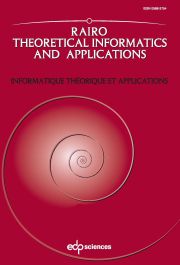Article contents
The perfection and recognitionof bull-reducible Berge graphs
Published online by Cambridge University Press: 15 March 2005
Abstract
The recently announced Strong Perfect Graph Theorem states that the class ofperfect graphs coincides with the class of graphs containing no inducedodd cycle of length at least 5 or the complement of such a cycle. Agraph in this second class is called Berge. A bull is a graph with fivevertices x, a, b, c, d and five edges xa, xb, ab, ad, bc. A graph isbull-reducible if no vertex is in two bulls. In this paper we give asimple proof that every bull-reducible Berge graph is perfect. Althoughthis result follows directly from the Strong Perfect Graph Theorem, our proofleads to a recognition algorithm for this new class of perfect graphs whosecomplexity, O(n6), is much lower than that announced for perfect graphs.
Information
- Type
- Research Article
- Information
- RAIRO - Theoretical Informatics and Applications , Volume 39 , Issue 1: Imre Simon, the tropical computer scientist , January 2005 , pp. 145 - 160
- Copyright
- © EDP Sciences, 2005
References
- 2
- Cited by

